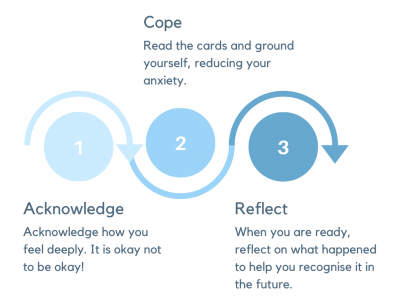
A 3-step process to help you overcome moments of high anxiety and stress. Anxiety is similar to a snowball and in order to prevent symptoms getting more severe, it needs to be addressed early.
If you start to feel unwell, physical pain, a dry throat or heart palpitations, please refer this 3-step process that will teach you how to use your coping cards and how to overcome moments of anxiety. If you also start to notice your thoughts becoming out of control, causing worry and other physiological symptoms of anxiety, the following steps will help you.
Step 1: Feel & Acknowledge
Acknowledge how you feel and accept that you are having these emotions. It is okay not to be okay! Here, it is most important to STOP what you are doing and focus on the present moment entirely by drawing attention to physical and emotional sensations. Feelings can be acknowledged by explicitly saying to yourself phrases like the following:
- I feel my heart rate rising.
- I can feel more sweat on my body and my throat feels dry.
- I am aware that I am having a panic attack or am about to have one.
- I am thinking … and this causes me to worry that … might happen.
By doing this, you do not allow yourself to ignore the subtlest of signs of panic and anxiety and puts you in a better position to address your anxiety. At this stage, you are creating what is called “Body Awareness.”
Step 2: Cope
Whatever coping mechanism you are using, just know that everyone is different. In moments of high anxiety and stress, we need to find a coping mechanism to ground us. This is the exact purpose of the Coping Cards: to ground you. Noticing the tactile feel of the cards, we want you to read them in a place you feel comfortable. While you read them make sure you are taking long and deep breaths, holding for a couple of seconds at the top and bottom of each breath.
Make sure that you focus entirely on every word and sentence on the cards to bring you to the present moment and draw attention from any unhelpful thoughts. The phrases on the cards also give you reassurance that you will be okay, helping you calm down sooner.
Read one card after the other and feel the how the anxiety reduces and how the cards help to ground you.
Step 3: Reflect
When you are ready it is time to reflect on what has happened and what it was that triggered your anxiety. This will help you to recognise symptoms in those stressed moments of anxiety sooner and sooner, helping you address the issue earlier and ceasing escalation of anxiety.
A useful tip when reflecting is if you can notice patterns in what causes you worrisome thoughts. Ask yourself the following questions to help you identify and analyse your anxiety:
- What was I physically feeling when I started feeling anxious?
- What was I thinking right before I started feeling these physical sensations?
- Was there an event that caused an extreme negative emotion?
- What was the intensity of my emotions and physical feelings on a scale of 1 to 100?
- Which coping card phrases helped me calm down and resonated with me the most?
If there was a particular event that caused your thoughts to spiral or for your anxiety to rise, it can be a good idea to follow your train of thought during reflection. For example, engage in some of the “Thought Discovery” questions below.
- “What is bad about … happening?”
- “What is it that I see happening in this situation?”
- “What are the best- and worst-case scenarios?”
- “What am I concluding about myself or others in this situation?”
- “… and that is bad because…?”
- “… and what does this say about me…?”

